(en bas de page se trouve un résumé en français)
[ last update: 11.04.2014 ]
The (new)
Cadillac Database©
The Cadillac V-16
Series 452-452A
1930-1931
The European Tour Cars
Return to The (New) Cadillac
Database© Index Page
or go back to the V-16 index page
![]()
(en bas de page se trouve un résumé en français)
In June of 1930, the Cadillac Motor Car Division of GM sent a half-dozen of the most representative sixteen-cylinder models to Europe, on a promotional tour.
There was initially some debate as to which Sixteens were part of the tour. In his excellent book Sixteen Cylinder Motor Cars, my friend Roy Schneider mentions a first group of Fleetwood-bodied Sixteens that traveled the U.S. auto show, salon, and dealer showroom circuit; these included a close-coupled sedan (style #4330-S), an all-weather phaeton (style #4380), a "sport" or "special" phaeton (style #4260), a town car with special cane work on the lower rear quarters - one of only three built this way (style #4264-B) - and a convertible coupe (style #4235), among others. Roy said also that six "Sixteens" were sent to Europe, in June; he did not identify these. From what I learned later, after consulting some old issues of General Motors World magazine from 1930, it appears that only FIVE cars made the trip from America and in the various countries visited by the five tour cars. These are illustrated below. The sixth V-16 that appears in a photo taken during the tour, in Germany, probably was added there by the local Cadillac dealer in that country, Eduard Winter of General Motors GmbH.
In one of the many reports published in relation to the event, the writer declared: Their various color schemes were chosen with the idea of having each car contrast with every other. Regrettably, I have seen no color photos of ANY of the five tour cars to better appreciate that statement.
The five "European Tour" V-16 Models
(these are factory photos and may not be the actual cars that were shipped)
Fleetwood Style #4175 Madame X limousine
[ cropped factory photo ]
Fleetwood Style #4235 Convertible Coupe
[ cropped factory photo ] - the tour car apparently had Body #1
Fleetwood Style #4260 Special Phaeton
[ cropped factory photo ] - the tour car apparently had Body #2
Fleetwood Style #4264-B Town Brougham, with canework on rear body
[ cropped factory photo ]
Fleetwood Style #4330-S Close-Coupled Sedan
[ cropped factory photo ]
An additional V-16 model (Fleetwood Style #4376 Stationary Coupe)
was shown at one or more tour destinations (in Germany, e.g.); I assume
it was supplied by the Cadillac dealer there; it was NOT a part of the Caravan
Shipping dates and destinations
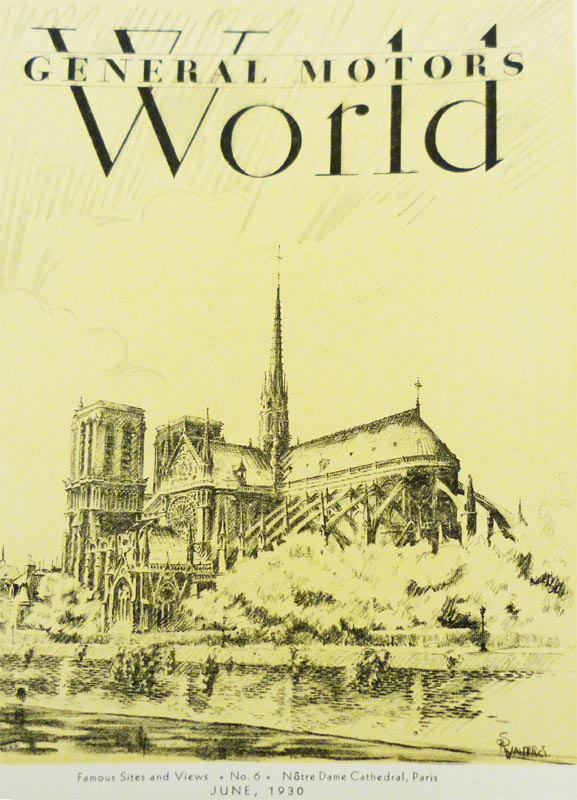
The June 1930 edition of General Motors World
(Cover illustration: Notre Dame cathedral in Paris)
As mentioned above, there was debate as to the actual shipping date from New York. According to GM Motor World, issue for June 1930 (that was probably typeset in April or May 1930), the cars were scheduled to leave New York aboard the S/S "Deutschland" on June 12, 1930; in fact they shipped on another vessel, the "SS United States". A tentative itinerary was mentioned but in the end it was not entirely followed. The planned route was to be: France [Paris] (June 23-27), Belgium (June 30 to July 5), Holland [Netherlands] (July 7-10), Denmark [through Germany to Copenhagen] (July 14-16), Sweden [Stockholm and others] (July 21-25), Germany [Berlin, (July 28-31), Munich (August 8)], Switzerland (August 10-15), Spain [San Sebastian] (August 25). A press cutting published in New York's "Daily Eagle" said the five cars would tour Great Britain (inset).
This press cutting from June 22, 1930, provided kindly by Anders Läck, shows
how much we should take published news with a large pinch of salt; no "tour of
Great Britain" ever took place; the cars left New York aboard SS United States
(NOT France) and the itinerary did NOT begin in Paris but in Copenhagen
One known factory record sheet (of which former owner and V-16 enthusiast, Steven Nanini of Arizona has a copy) indicates that the special phaeton (Style #4260, body #2) was shipped from the factory on June 11, 1930, bound for Copenhagen; that information ties in with historian Alan Markel's findings. Writing in the seventies, Alan said the cars had been shipped first to Copenhagen, in Denmark. In the definitive book on Fleetwood coachwork published in 2001, author James Schild asserted that the tour had begun in Paris, on June 21, 1930.
Later research conducted in Sweden by my friends Anders Läck, his close friend Anne, and Jan Ströman revealed this factual information: the cars were boxed and were shipped from New York directly to Copenhagen aboard the Danish (DFDS) steamship, S/S "United States"; in those days, DFDS carried freight to and from Copenhagen to both the USA and France). The cars were offloaded at the Copenhagen wharf on June 25, 1930 (one published report gave the "auspicious start" date as June 24). They were taken (by truck or under their own power?) to the GM factory premises in the south harbor (in 1923, GM's first European assembly plant was established in Copenhagen under the name General Motors International A/S; it was to build Chevrolet cars for sale in Scandinavian countries, the Baltic, Germany, Poland, Czechoslovakia, Austria, Hungary and Russia; the first GM vehicle assembled outside the U.S. and Canada was a Chevrolet utility truck; it came off the Copenhagen assembly line on January 7, 1924).
This is the actual steamship that ferried the Sixteens from New York to Copenhagen
Licensing
Until this year (May, 2014) I was not able to determine with any certainty when and how the five cars got the temporary French license tags they bore throughout the duration of the tour of 8 out of the 9 countries visited, Germany being (apparently) the sole exception. Throughout the tour all the cars carried French "tourist" license tags with the suffix "XB". That suffix is a sure indication that these temporary tags were issued in France's Seine inférieure region; they could only have been issued in Le Havre or possibly in Rouen (the district capital of Seine inférieure). Who issued them? Where? When? We do not know for sure. It was my initial belief that the cars had been offloaded at Le Havre (which is one of the larger, French, merchant sea ports on the Channel, offering access from the North Atlantic to the North Sea and the Baltic Sea in the east) and that they had travelled to Denmark, by road, via Belgium, the Netherlands and Germany. However, further investigation by Anders, Anne and Jan suggests that the cars traveled directly to Copenhagen; Anders believes the French license tags (although from France's Seine inférieure) were issued there, in advance, at the request of General Motors (France) in Paris; in that case they would have been delivered by mail or courrier General Motors International A/S in Copenhagen. The French authorities certainly must have had all the necessary vehicle information, model descriptions and VINs to allow the licensing process to take place without the cars being physically present in Seine inférieure. Why and when the tags were issued in Seine inférieure rather than in the French capital remains a mystery! Thierry Baudin of France, a specialist in French automobile history, sent this interesting piece on licensing, in France, of automobiles issued to (temporary) foreign visitors. He wrote: The topic is quite familiar today; the "XB" series was used in France's Seine Maritime [Seine inférieure?] region from 1928 to 1933 to import temporarily, duty-free, and register the automobiles of foreigners disembarking at Le Havre [my emphasis] to visit France and other countries in Europe. In the case you mention, it would appear that the Cadillacs did not disembark at Le Havre, but proceeded on to Denmark; that situation is less common [again my own emphasis]. In France, since 1919, there has been a preferential trade agreement between France and the USA that allows US cars to be imported by foreign tourists and for them to obtain temporary title documents (in France, the "carte grise" or gray card) without the need to present to the authorities any other document than the US "title" [Mr. Baudin was not sure if similar trade agreements were signed with any of the other countries visited during the Tour]. A simple stop at a French port was all that was needed to provide the cars with a French "identity", allowing them to drive in all the selected countries on the strength of their French "carte grise". This preferential treatment meant the cars were not required to undergo any technical inspection (such as required under DOT - Department of Transport - regulations in most countries including the USA); the only requirement was to show the authorities the US title documents. In addition, requests (for such French title documents) could be made in advance, in particular by the shipping company on whose vessel the cars were carried. For example, on arrival at Le Havre, I do not believe the cars had to be off-loaded; their mere presence as cargo loaded aboard ship [I guess a copy of the ship's Bill of Lading would suffice] was enough for customs and licensing authorities to deliver a "carte grise" to each car. Thierry added: assuming the French "carte grise" documents still exist (in the archives of the French licensing authorities) these will show important information relative to each car such as date of issue of the "carte grise" and the identity of each owner. That information would be available also for the "missing" tag in the series (i.e. 2147XB ... which may not even be a Cadillac!)
The five cars were duly titled in France throughout the time they visited 8 out of 9 of the countries listed on the final itinerary; in Germany, the 4th out of the 9 countries visited, the French "tourist" tags appear to have been removed (or hidden) and replaced (temporarily) with oval German tags until the cars entered Holland some 19 days later (note that in one photo taken in Berlin, the #4175 limousine still carries French plates; no other "country tags" are visible in any of the remaining tour photos).
About oval German tags, this information was gleaned from Wikipedia: The former, oval tags were called "Customs tags" because, for decades, they had a dual function ... (a) export tags, in the current sense of the term, and (b) foreign vehicles imported [temporarily] into Germany had to be replaced by export tags at the [German] border. The foreign tag was removed or hidden. When the vehicle left Germany again, the "Customs tag" was removed from the vehicle [again] at the border.
The French tags you see are in numerical sequence, except for one of them [I wonder what car - make and model - got the out-of-sequence tag #2147XB?]. Here are the five French license tag numbers; I have listed the car VINs in sequential order, with the factory shipping dates, individual body style and types, body numbers (when known) and corresponding French (temporary) tag numbers:
VIN Ship Date Body Style # and Type
Body # French Tag Notes
701551 June 10 4264B Town Car unk. 2149XB 6 of these Fleetwood "Town Broughams" were built, only 3 had cane-work applied to the rear body 701552 June 06 4330S Sedan unk. 2146XB 394 of these standard 5-pass. cars were built 701553 June 10 4175 Limousine unk. 2148XB 86 of these flat-windshield, 7-pass Madame X limousines were built; 24 others had the Pennsylvania "Split-V" windshield 701554 June 11 4260 Special Phaeton 2 2145XB 85 were built; the chassis of this car was used later to receive custom bodywork by Jacques Saoutchik; later still, the Saoutchik job was removed and put on another V16 chassis and VIN701554 got back its original body*) 701555 June 11 4235 Convertible Coupe 1 2150XB 94 were built *) This is body #2, although another published source says it was #1; I have a copy of the build sheet for VIN701554; it was owned for many years
by Steven Nanini (AZ) who subsequently sold it to Dennis Sobieski; the car carries CLC Senior car #141].
The Tour Itinerary
As shown on the above chart, the cars left the factory, in Detroit, between June 6 and June 11; allowing for the Atlantic crossing, this means that the cars could have reached a European port of disembarkation on June 20-21. We now know for sure that they disembarked in Copenhagen, Denmark, on June 26 although Jim Schild reported them in Paris 5 days earlier, on June 21.We know now that the actual travel route was New York to Copenhagen (with a possible stop at Le Havre). Thanks to my Swedish friend, Anders Läck, I obtained in March and April 2012 some Swedish auto club magazines all containing useful historical information about the Tour. My knowledge of Swedish does not extend beyond a few words gleaned in an Ikea furniture catalog; fortunately, however, Gita and I were able to spend an evening with Anders and Anne, who were driving north to Pennsylvania following their annual visit (and ours) to the Amelia Island Concours d'Elégance. They were able to provide further information on the dates and places of the tour. Anders confirmed that the Tour had definitely begun in Copenhagen.
The tour dates and locations, in Sweden, are fully documented; they point to the fact that the cars did not stay long Norway. Anders consulted Sweden's central library, the Kungliga Biblioteket or "Royal Library" where he noted that the caravan of FIVE cars had driven from Oslo to Stockholm on July 1, via Karlstad and Örebro, reaching Stockholm that same evening. He noted in Dagens Nyheter [the Daily News?] for July 2, a short article and a photo of five of the tour cars posing in front of Sweden's Grand Hotel. The article reported that the caravan had effectively started out from Oslo on the morning of July 1. It was said that the cars would be in the Marble Halls [Hans Osterman's renowned Cadillac showrooms in Stockholm] for two days.
Sure enough, on Wednesday and Thursday July 2 and 3 the cars were effectively on display in those showrooms. One photo taken at the time shows that King Gustaf V of Sweden even paid a visit there on that occasion ... but he did not buy one of the big, new V-16, cars even though he was a keen admirer of Cadillac and LaSalle automobiles. He had one already; he had bought it some time before the start of the tour.
Cadillac V-16 European Tour - 1930
Denmark, Norway, Sweden, Germany, Holland,
Belgium, France, Switzerland and Spain
This is the itinerary I determined, based on facts, press cuttings, original photos ... and some guess work!
The purple arrows show the assumed direction of travel
The Actual Tour Itinerary
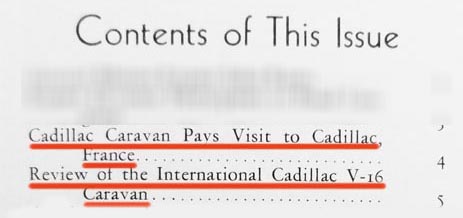
We are told in so many cuttings, including the Dutch snippet below (supplied kindly by Dirk Van Dorst, CLC Coordinator for European Cadillac activities), that the international Cadillac Caravan cars were shipped from USA on June 12, 1930, aboard the S/S Deutschland that left Copenhagen (by road) on June 24, after an Atlantic crossing lasting TWELVE days. In the magazine General Motors World for June 1930, the tentative Tour itinerary was to have been: Paris (June 23-27) - suggesting that the Atlantic crossing would take 11 days. There were to be stops in Belgium (June 30 - July 5), Holland (July 7-10), then a direct run through Germany to Copenhagen (July 14-16), Stockholm (July 21-25), Berlin (July 28-31), then another run through Germany to Munich (August 8), Switzerland (August 10-15) and San Sebastian, which was to be the last stop, on August 25.
That is NOT how it happened. In fact, in a later issue of General Motors World (November 1930), the tour is said to have ended in Paris, France, on September 9, 1930. The precise itinerary is not known for sure, but the order in which the cars proceeded seems now to be well established. Below are the actual countries, dates and towns mentioned specifically in published reports of which I have been able to examine authentic copies; they include a number of issues of General Motors World and one issue of General Motors Continental. I anticipate that missing dates and places may be included in one or more missing issues of these magazines.
The tour began (as stated earlier) in Copenhagen, Denmark and stayed there from June 26-28); on that score, the planned itinerary and dates mentioned in the June 1930 edition of General Motors World are incorrect. We have seen how the Caravan of cars reached Copenhagen on June 26, having left New York on June 12.
According to this Swedish web site that I visited in early 2012, the FIVE cars subsequently "disembarked" in Oslo, Norway, on June 30, 1930; this suggests a sea passage from Denmark to Norway. In fact the caravan travelled to the Norwegian capital mainly by road, with a ferry crossing from Copenhagen to Helsingor. This tour schedule in the Scandinavian countries seems to be the most complete and the most historically accurate: Copenhagen, Denmark (June 26-28), followed by Oslo, Norway, by ferry and road (June 29-30), then Stockholm and other cities in Sweden (July 1-5). In one newspaper cutting that Anders found it was said that there had been no time to exhibit the cars in Malmö, after the tour through other Swedish cities and towns, and so the Caravan had time only to continue south, directly to Trelleborg and there catch the ferry across the Baltic Sea to Sassnitz, on Ruden island (or peninsula), in Germany.
We now have a good idea of the order in which the caravan effectively advanced through continental Europe after leaving Sweden and entering Germany. Based on available photos (most of them undated), the Dutch clippings from Dirk Van Dorst and the two photos from Vittel, in France, the one in Spain in the book Cadillac Eldorado (mentioned above) and the ones in France (i.e. in Hendaye, Cadillac, Bordeaux, La Baule and Angers), we can see more clearly the route that was taken after the Caravan left Sweden :
(in Denmark from June 26-28): Mainly in the capital and surrounding areas;
(in Norway, June 30): Mainly in Oslo, the capital;
(in Sweden, June 29, July 1 to 5): Helsingborg, Hamlstad, Gothenburg, Carlstad, Örebro, Stockholm, Jönköping, Malmö;
(in Germany from July 5-6 to July 24): Berlin, Cologne, Dresden, Frankfurt, Hamburg, Munich, Nuremberg, Stuttgart, Wiesbaden and Cologne;
(in Holland from July 24 to 29): Arnhem, Utrecht (the cars were seen there on August 4), Amsterdam, The Hague and Rotterdam;
(in Belgium from July 29 to August ???): Antwerp, Brussels and possibly also Bruges and Ostende in order to reach the mentioned French Channel resorts);
(in France - first lap - from August ??? to 10): Unspecified French Channel resorts (I'm guessing Dunkirk, Calais, Boulogne-sur-Mer) en route south to Switzerland; the logical itinerary (in view of a reported stop in Vittel, France) would be Lille, Reims, Châlons-en-Champagne, Chaumont, Vittel (where a couple of photos were taken) and Belfort;
(in Switzerland, from circa August 10 to 15): Basel, Zürich, Lucerne, Berne, Lausanne - spelled "Lussan" in one report - Geneva (and, logically, the border town of St. Julien-en-Genevois to re-enter France);
(in France - second lap - on August 15): Aix-les-Bains and Nice (but logically also Grenoble, Gap, Sisteron, Marseilles, Avignon, Nîmes, Montpellier, Beziers, Perpignan and the Spanish border at Le Perthus) [another unconfirmed THEORY would have the five cars shipped by sea-freight from Marseilles to an un-named Spanish port, thence by road or rail to Madrid; if I hear any more about this plausible scenario, I will keep you posted via this web page];
(in Spain, from August 16 to 28 - that's almost 2 whole weeks): Madrid and San Sebastian, but logically also Barcelona, Lerida, Saragoza, Burgos, Bilbao and the Spanish/French border post at Irún;
(in France - third and final lap - from circa August 28-29 to September 9, another almost 2 weeks): Toulouse, Cadillac, Bordeaux, La Baule and Angers, but logically also Hendaye - the border crossing from Spain back into France - and either the direct route through Le Mans and Chartres, or the scenic route through the Loire Valley, Tours and Orleans to Paris, the final destination [Aside: in 1953, the company's designers named two of its custom Cadillac jobs Le Mans and Orleans; were they perhaps inspired by these two French cities, possibly visited by the five V-16 models during the European Tour that had taken place 23 years earlier?]
Based on these facts and the summary I got from Anders in January 2012, the "official" tour began in Copenhagen and ended in Paris. A reported nine countries were visited, in this order: Denmark, Sweden, Norway, Sweden a second time, Germany, Holland, Belgium, France, Switzerland, France a second time, Spain and France for a third and last time. There were 11 Border Crossings that I identified as (1) Denmark to Sweden, (2) Sweden to Norway, (3) Norway back to Sweden, (4) Sweden to Germany, (5) Germany to Holland, (6) Holland to Belgium, (7) Belgium to France, (8) France to Switzerland, (9) Switzerland back into France, (10) France to Spain and (11) Spain back into France and to the final destination being Paris. The various progress reports mention also 31 " formal showings" and 44 cities as having been visited, where the cars were presumably on "controlled public display" in hotels or dealership settings. I identified these, each one being mentioned specifically in one or more of the published reports: (1) Copenhagen, (2) Helsingborg, (3) Hamlstad, (4) Gothenburg, (5) Oslo, (6) Carlstad, (7) Örebro, (8) Stockholm, (9) Jönköping, (10) Malmö, (11) Dresden, (12) Berlin, (13) Nuremberg, (14) Munich, (15) Stuttgart, (16) Frankfurt, (17) Wiesbaden, (18) Cololgne, (19) Arnhem, (20) Utrecht, (21) The Hague (22) Rotterdam, (23) Antwerp, (24) Brussels, (25-27?) resort towns along the English Channel, (28) Vittel, (29) Basel, (30) Zürich, (31) Lucerne, (32) Berne, (33) Lausanne, (34) Geneva, (35) Aix-les-Bains, (36) Nice, (37) Madrid, (38) San Sebastian, (39) Toulouse, (40) Cadillac, (41) Bordeaux, (42) La Baule, (43) Angers and (44) Paris. The total distance traveled on the tour was reported to be 10,709 kilometers (6,693 miles) from start to finish (another source mentions 6,654 miles); I guess those figures are based on the odometer readings of one (or more) of the five cars that participated in the tour ... and include the "thousands of demo rides" mentioned in the related reports.
Misc. Tour Notes
According to V-16 owner and enthusiast, Steven Nanini of Tucson, AZ, the factory published a confidential Cadillac-La Salle Sales Bulletin; during the summer of 1930, all the (European and US) dealers got updated information on the tour from those bulletins. Unfortunately, Steven has found only a single example of that in-house publication; it is issue #37 of July 21, 1930. In it, the writer makes no specific reference to the European Tour of five V-16s. Interestingly, Steven told me in June 2014 that he had owned at one time the Fleetwood Style #4260 special phaeton that was one of the five European Tour cars; that car had been acquired by one Baroness Von Rosenberg of Vienna, Austria. Steve said: I am also sending a copy of a letter from [the late] Wayne Merriman dated March 11, 1987 which conclusively proves 701554 was the Sports Phaeton (4260) that I restored and ultimately sold to Dennis Sobieski [my emphasis]. As you can see from my Bill of Sale from Alain Rouhaud, my Sports Phaeton was sold during the European Tour [again my own emphasis] to Baroness Von Rosenberg and later received a Saoutchik body and was purchased by Alain Rouhaud who then sold it to me on January 28, 1987. I purchased 701554 under the advice of Wayne Merriman. Fred Weber of St. Louis, MO purchased the Saoutchik body and I fabricated a Sports Phaeton body [that was put on an authentic V-16 chassis - VIN 700979] to return 701554 to its original European configuration. The snippet (below), provided kindly by Swedish owner-enthusiast, Anders Läck, is from the Harrisburg Evening News for July 9, 1930. It confirms that the Baroness did indeed acquire in July 1930 a Fleetwood special phaeton (style #4260); however, THAT car is believed to have been body #1 of the first two units of that style; both are believed to have been shipped to Europe in June, 1930. Car #1 was offered for sale in California in the Self Starter Classified section in Nov.-Dec. 1967 (p.15).
We know that Paris' Jacques Saoutchik mounted a sedan body on this engine/chassis combination (VIN 701554) and fitted it with a special sliding roof (while in France, it carried license #8651RK2). The original sport phaeton body (#2 of the run of 82 units built in 1930-31) is rumored to have survived and to have been mounted, later, on another V16 chassis. The "converted" car (still VIN 701554) was owned in 1960 by an elderly lady (89 years old) and would have been sold at auction by a Paris garage, had she not sent an agent over in the nick of time to pay an outstanding repair bill. A few years later that car is said to have been acquired [from the elderly lady's estate?] by auto dealer, Johnny Thuysbaert, then later by the late Serge Pozzoli, editor of France's Le Fanatique de l'Automobile; Serge subsequently sold the car to Hubert le Gallais, former CEO of "Poker" beers, in France, and a restaurateur in Fontainebleau then in Brittany. My question: who is Alain Rouhaud in relation to Johnny Thuysbaert, Serge Pozzoli and Hubert Le Gallais who all owned the "converted" phaeton in the 60s and 70s? BTW, the "converted" car subsequently returned to the USA in the 80s where it was completely (over)restored. It has changed hands a few times since then. My personal feeling is that the car that won a prize in Vienna was #1, while Saoutchik worked on #2, the car that participated in the promotional tour of Europe in June 1930. There is also a distinct possibility that BOTH special phaetons (#1 and #2) were shipped to Europe at the same time.
There is reliable evidence that on July 9, 1930, Fleetwood special phaeton (body #2) was
traveling en route from Malmö, in Sweden to Germany where it was to visit Berlin,
Cologne, Dresden, Frankfurt, Hamburg, Munich, Nuremberg, Stuttgart, Wiesbaden and
Cologne; there is no evidence that THIS car (either alone or together with the other V-16s
in the "tour group") made the 220-mile trip to Vienna, Austria; moreover, that country
is NOT listed among those included in the V-16 tour itinerary
So far as we know, Vienna was NOT one of the European Tour destinations. On the other hand, that Viennese Concours was staged during the time the five Sixteens were touring in Germany ... but Vienna is more than 200 miles from Munich. According to another clipping kindly provided also by Steven Nanini and published circa 1992, entitled Looking back ... the 1930 V-16, the writer asserted: In July [1930] the V16s [plural] won prizes in Vienna. In the same article it was asserted that the five V-16s were loaded onto the S/S Deutschland in New York; again, mistaken information. The writer went on to mention a visit to the ancient seat of the Cadillac family in the Bordeaux region of southern France, as well as the Dukes of Epernon, claimed to be the ancestors of the Sieur Antoine de la Mothe Cadillac. In a second, similar paper supplied by Steven, also from circa 1992 and entitled Welcome Home - Goodwill Ambassadors, the writer (Donald S. Hoeft of GM International Export Sales), states the same erroneous facts, possibly gleaned from (or supplied to) the writer of the earlier clipping. Hoeft says King Gustav of Sweden was in admiration of their (the Cadillac's) excellent coachwork and mechanical perfection. This does not tie in with the opinion of Hans Osterman, Sweden's highly regarded Cadillac dealer; in a letter of July 21, 1930, to then GM President Alfred P. Sloan, Osterman wrote: His Majesty expressed as his opinion that these cars did not give a real comfort, especially in insufficient leg and head room. Of course, Osterman omitted to mention the fact that King Gustav V stood more than 6 feet and 3 inches tall! Hoeft mentions also the V-16 Caravan's visit to the French town named for the family of the founder of Detroit; he refers to the Dukes of Epernon as the ancestors of Le Sieur Cadillac, describing him as the town's illustrious son. Once again, this is all "historical misinformation". There is no (known), noble "Cadillac family" anywhere in France; the self-styled Sieur Antoine de la Mothe Cadillac was a commoner (albeit an adventurous one; he was born Antoine Laumet in the small township of St. Nicolas-de-la-Grave, located some 80 miles south-east of Cadillac and some 100 miles south-east of Bordeaux; he created for himself the alias de la Mothe Cadillac at the time he married the daughter of a French privateer, in Canada, in 1687. The true facts about le Sieur Cadillac are to be found in this section of the Cadillac Database.
Photoshoot Locations
(in chronological and geographical order)
Denmark
My friend Anders said that on Thursday evening June 26 the V-16s where shown in the Palmehaven (a huge glass hall known as the "Garden of Palms") of the Hotel d'Angleterre (established in 1755, that hotel is an icon and a Copenhagen landmark celebrated for its elegance, luxury and style). Another published record reads: The first showing [in Copenhagen] was held in the Angleterre Hotel where the convertible coupe and the town brougham were displayed in the tea room before an audience of invited guests comprising distinguished citizens of the town." [ ... ] Outside the hotel, where great crowds surrounded them, the other three models were parked on bright red carpets. These cars took invited guests on ten minute demonstration rides and were kept busy for two hours by many eager applicants. In the same published record, it is said that: On the following evening about 200 members of the Royal Society of Engineers were invited to the Industry Building to see the cars on exhibition there and to receive demonstration rides. Mr. Lundsgaard, Sales Promotion Manager, gave gave a short lecture on the V-16 Cadillac and answered many questions from his audience.
On June 27 the cars where shown by General Motors International A/S, and on Saturday June 28 they were shown by the Danish Cadillac dealer, F. Bülow & Co. Anders was able to provide a photo (below) from the collection of Danish enthusiast, Uffe Mortensen, taken in front of those showrooms.
That same evening the cars traveled by road, a mere 28 miles, to Helsingör [or "Elsinore", where Shakespeare's "Hamlet" contemplated suicide]; there they boarded the ferry to Helsingborg, in Sweden (just 2 miles and 20 minutes away). From there they traveled again by road to Oslo, in Norway, via Halmstad and Gothenburg in Sweden; there was a successful showing of the cars in Gothenburg. The total mileage for the trips from Copenhagen to Oslo was 577 kilometers (360 miles).
Copenhagen's prestigious Hotel d'Angleterre
The Swedish contingent: Mr. Winstedt, C.H. Fleming, P.S. Steenstrup, Mr. & Mrs. T.W. Hendersson, Mrs. Steenstrup,
Mr. Osterman (hidden), S.W . King, Mr & Mrs. G.T. Carroll (two more unidentified?)
Fleetwood style #4235 conv. coupe in the lobby of the
Hotel d'Angleterre in Copenhagen
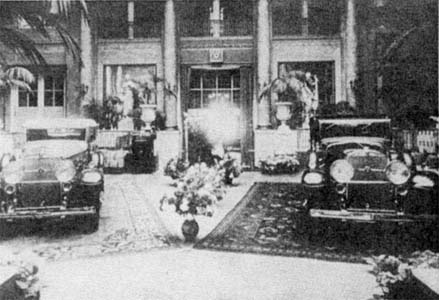
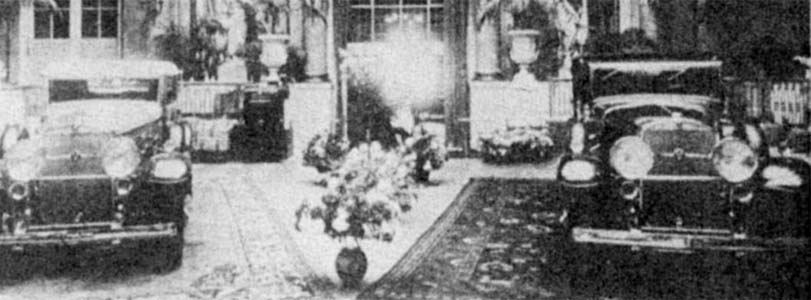
The Hotel d'Angleterre was decorated with fine oriental rugs:
(left) Style #4235 convertible coupe; (right) Style #4264B town brougham
From L to R: Fleetwood V-16 models #4330-S, #4260 and #4264-B
[ Photo: © and courtesy Uffe Mortensen, Denmark ]
Norway/Sweden/Norway
On Sunday June 29 and Monday June 30 the cars were in Oslo. To date, however, I have seen no record of any showing or exhibition of the V-16 models in the Norwegian capital. There are no known photos of the cars, either in Oslo or en route from Copenhagen to Oslo.
Sweden
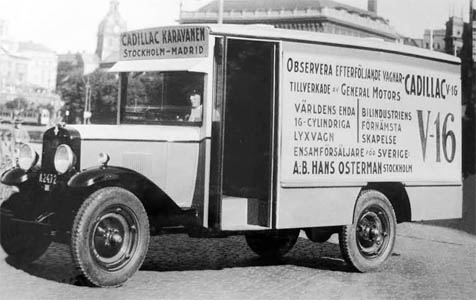
This advertising truck followed the tour cars throughout the Swedish part of the itinerary
The text in front of the truck reads: Cadillac Caravan, Stockholm – Madrid. On the side it reads:
Look out for the Cars that are following; they are made by General Motors: the CADILLAC V-16
The World's only 16-cylinder Luxury Car // The car industry's premier Creation: V-16
Exclusive dealer for Sweden: A.B. Hans Osterman, Stockholm

Reception for European Tour organizers in the premises of Mr. T.W. Hendersson
Starting on Tuesday July 1, the cars proceeded by road to Stockholm. At that time, a notice was posted indicating that the cars would later be visiting all the main cities in Europe, except those in Poland and in the Balkans. The latter information was obtained from my friend Anders Wald, a member of the Swedish Cadillac Club; he had got the information from the library in Copenhagen. It was confirmed later by the other Anders (Läck), his friend Anne, and Swedish auto historian Jan Ströman when they looked at records held in the former Hans Osterman archives in Stockholm (Osterman was the Cadillac dealer in that city); those records confirm that the V-16 Caravan traveled by road and ferry from Copenhagen, through Swedish towns to Oslo and then on to Stockholm in Sweden.
Swedish automobile enthusiasts mill around the parked V-16s
(Left) Style 4330S sedan; (right) Style 4260 Special Phaeton
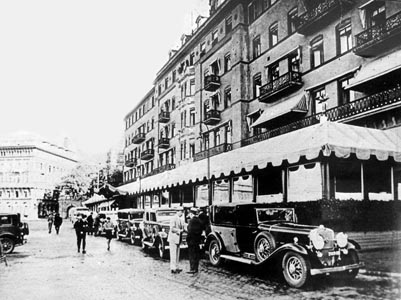
The five V-16s are pictured here; they are parked outside Stockholm's Grand Hotel; the #4264-B town brougham leads the way
[ Photo (and detail): Autohistorica 3/71, courtesy <www.massingnickel.se> ]
The Town Brougham ... somewhere in Sweden?
Outside the Royal Swedish Automobile Club HQ in Stockholm
[ Photo: Autohistorica 3/71, courtesy <www.massingnickel.se> ]
I thought, initially, that these cars were photographed in front of Stockholm's National Museum entrance; however, Rickard Johansson Wolrath, Editor of Sweden's Classic Motor Magasin wrote (in Feb. 2002) to say that, in fact, the photo was taken in front of the Swedish Royal Automobile Club (the KAK, Kungliga Automobil Klubben); the Swedish leg of the caravan actually started from there. The KAK building was (and still is - in 2014) located next door to the National Museum in Stockholm: it is probably the museum seen in the background; since that photo was taken, the entrance has been rebuilt.
I have seen no photos of the V-16 Caravan of Cars en route from Stockholm to Malmö and Helsingborg.
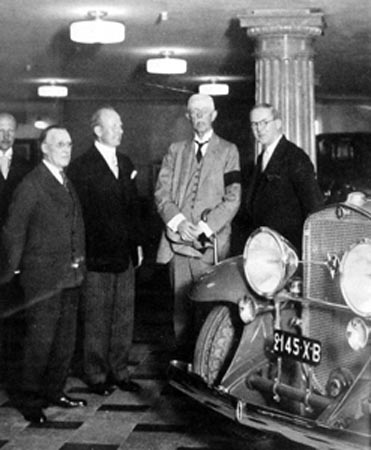
From L to R: Mr T. Hendersson [an expatriate Swede?] in charge of the Cadillac V-16 European Tour,
Hans Osterman, director of the Marble Halls showroom, HM King Gustaf of Sweden
and Mr. Steenstrup, the showroom supervisor [inset: Hans Osterman]The photo shows clearly that the car(s) carried French "tourist" tags while they were touring in Sweden
[ Photos: Autohistorica 3/71, courtesy <www.massingnickel.se> ]
Stockholm
This "Google Earth" view of Stockholm's Grand Hotel (at left) and the Royal Automobile Club (KAK - in the center)
were submitted kindly by a friend and confirmed Cadillac collector, Jerry Jansson of Sweden
In company with Jan Ströman, the Swedish auto historian, Anders & Anne made a number of trips to the Hans Osterman archives at the end of April 2012. They came way with a detailed map of the Swedish leg of the tour as well as some interesting correspondence from 1930 about the tour organisation. In one private letter from Hans Osterman, the latter mentions that the cars had covered already 500 miles in the USA (that is the estimated distance by road from Detroit to New York) and then 1600 km (1000 miles) to Stockholm.
On Friday morning July 4 - while America celebrated Independence Day - the Sixteens left the Swedish capital city and embarked on a tour of some of the major Swedish cities and towns. The caravan was split into two groups: the Madame X limousine and the 2-pass. convertible coupe (cars 2148XB and 2150XB) took the northern route, via Örebro and Jönköping, while the special phaeton, the town sedan and the luxurious town brougham (cars 2145XB, 2146XB and 2149XB) followed the southern route, both heading from Stockholm to Malmö ... a further almost 500-mile trip.
Anders noted also in the Swedish weekly magazine HVAR 8 DAG [#28, of July 13, 1930 - p.435]: ... after that [the caravan would travel] to the major cities in all European countries and thereafter the tour will dissolve in San Sebastian. We shall see, later, that San Sebastian was NOT the final tour destination.
Swedish auto historian, Jan Ströman, got the same information from the same magazines and subsequently reported his findings in Autohistorica, Sweden's premier historic automobile club magazine. Jan mentioned to Anders that GM Nordiska (agent for all of Scandinavia) used to issue a monthly magazine called General Motors Runor; the issues from 1928 to 1932 are on file in Stockholm's Royal Library; Anders and Anne checked out the place and got confirmation of the information now included here. Jan also mentioned to Anders another monthly magazine issued by General Motors in Detroit; he had a few issues of it from 1928 but no later. Jan strongly recommended that we seek out any issues of said magazine for the period from 1929 to 1931; he thought that some of them might include references to the "V-16 European Tour".
Indeed, Jan! When I visited the GM Heritage Center in Warren, MI, in May 2012, I was able to consult three issues of that magazine (those for June, August and November, 1930); all three make references to the Tour. I have put out some additional "feelers" to try to locate further relevant issues of that magazine; I suspect that the issues for May, July, September and December 1930 may reveal further interesting facts.
Anders and Anne continued their search of the archives in Stockholm's Royal library. They found also an article from Svenska Dagbladet [Swedish Daily?] , for July 1930 where it was said that the Tour would drive through Sweden and then to most parts of Europe - again ending in San Sebastian, Spain. They found also an advertisement from the Göteborg Morgonpost [Gothenburg's Morning Post] referring to a showing of the cars in that city.
In a published report commenting on the success of the V16 caravan tour in Denmark and Sweden, it was said that the Cadillacs left Scandinavia on July 5, en route to Berlin.
Thanks to my Swedish buddy, Jerry Jansson, here is the translation:
A procession of five 16-cylinder Cadillac automobiles will be arriving in Gothenburg on July 5, 1930 and a demonstration will take place in the Mässhallen [showroom] from 9.30 am until 12.30 in the afternoon.
No-one should neglect this opportunity to view these new carriages by Cadillac, the World's premier automobile.The HJ WALLIN Automobile Company, Gothenburg,
General Motors authorised dealer
Jerry Jansson came to the rescue once again; he said that Bilistisk is a word seldom used in Swedish; the prefix, bil, means car (i.e. automobile); the suffix, istisk has the same
meaning as the Anglo-Saxon suffix, istic which means pertaining (or relating) to ...; so it would not be wrong, I guess, to translate the headline as: Exhibition of Luxury CarsFour of the five sixteen-cylinder Cadillacs that reached Stockholm this Tuesday evening and are now on show by Hans Osterman Co. Ltd.
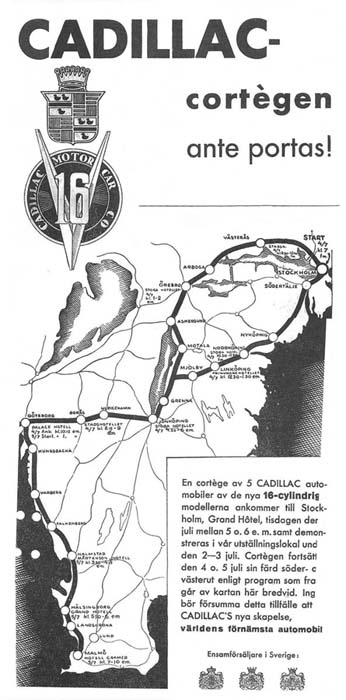
Some words or letters are missing from the caption, on the right; nevertheless, Anne was able to give me this translation:
A procession of five CADILLAC 16-cylinder automobiles will come to Stockholm's Grand Hotel on Tuesday 1st July between 5 and 6 p.m.; a demonstration of the cars will follow, in our exhibition hall, on 2nd and 3rd July. The caravan of cars will then proceed on its journey south and west, on 4th and 5th July, according to the program shown on the attached map. No one should neglect this opportunity to see CADILLAC’S latest creation,
the World's premier automobile
While the publicity made around the Sixteens is flattering, to say the least (and we should not expect less from the new Standard of the World, it was ascertained from Hans Osterman's correspondence (discovered in the firm's archives) that he was actually quite disappointed at how Mr. Henderson (the tour organizer from Detroit) and his party had done their job. He reflected that they had not acted in a very professional manner. In addition, there is a letter (cropped copy below) from Mr. Osterman to the Paris office of GM Export Corp., another to Alfred P. Sloan, as well as the latter's reply, indicating that Mr. Osterman was NOT particularly impressed with the quality, style and reliability of the five V-16 cars he got for the tour:
- "It was discovered that the ignition was altogether wrong ..."
- "I think it is a disgrace that cars as expensive as this should be in an inferior shape after such a short drive ..."
- "These cars do not nearly live up to the distinction which you wish to give them ..."
- "The 7-passenger Imperial Sedan could not seat 7 people comfortably ... it was crowded ... [there is] no more space than in any
ordinary, medium-priced car."That could be one of the reasons why so little information seems to have been published, about the tour, subsequently, in the other European countries that were visited.
Letter by Hans Osterman to
GM Motors Export Co., on 9th July 1930,
following the Swedish leg of the European Tour1.
2.
3.
4.
5.
6.
Letters exchanged between Hans Osterman and
GM President, Alfred P. Sloan, following
the Swedish European Tour program
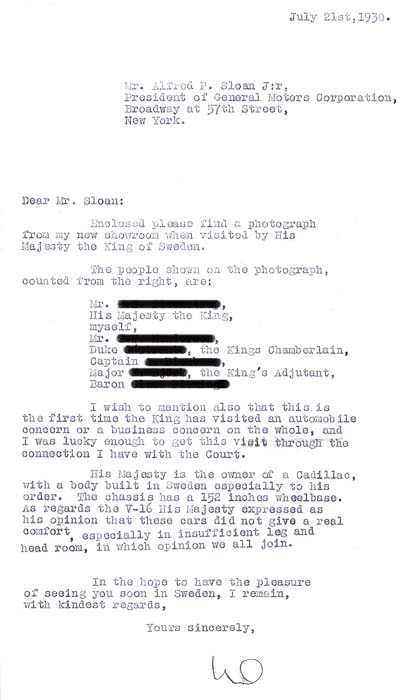
Two of the Cadillac cars owned
at the time by HM King Gustaf
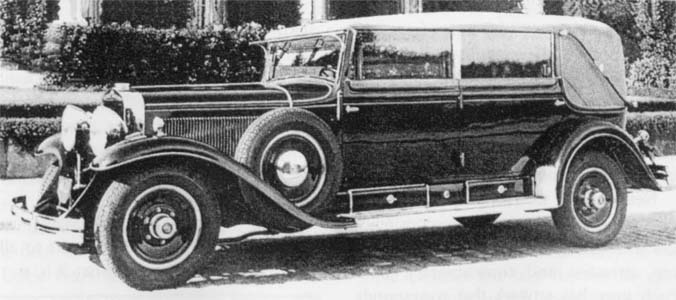
Custom stretched 1930 landaulet by
Alexis Kellner, Berlin
[ Photos: Fred Summers, CLC ]
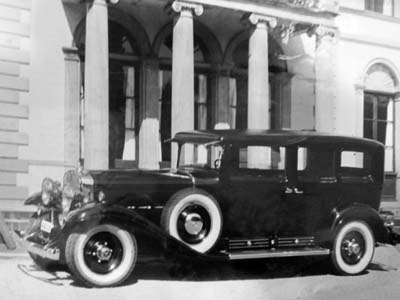
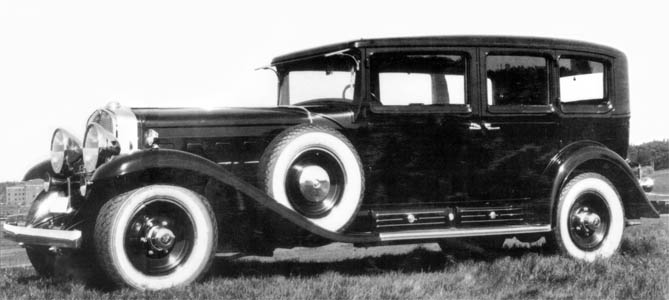
This is the regular V-16 limousine by Fleetwood - Style #4375, acquired by the King in June 1930 (before the European Tour began)
Germany
The cars are presumed to have left Scandinavia around July 22-23, embarking in Trelleborg at the southern tip of Sweden and disembarking the same day in Sassnitz, on Ruden island (or is it a peninsula?) in Germany, after a sea voyage of 60-70 miles south across the Baltic sea. It is my educated guess, looking at the map of Europe, that the cars probably drove through Germany along this itinerary: Rostok - Berlin - Dresden - Nuremberg - Munich - (Ulm) - Stuttgart . Wiesbaden and Cologne. That is the order in which I have shown the known photos of that section of the Tour. The German portion of the tour lasted around 19 days ... the longest lap of the entire journey.
I have seen only one photo of a single V-16 taken in Berlin, the first destination for the Tour cars after Sweden. According to the available progress reports, there was to have been a reception there laid on by General Motors G.m.b.H and the local Berlin Cadillac dealer, Eduard Winter. But let's not forget that a second world war began 9 years later, in 1939, and lasted for some 7 years; during that time the opposing factions (Germany on one side, the Allies on the other) wreaked havoc on each other. In the major German cities, few buildings were left standing during the conflagration.
Berlin
The Altes (old) Museum
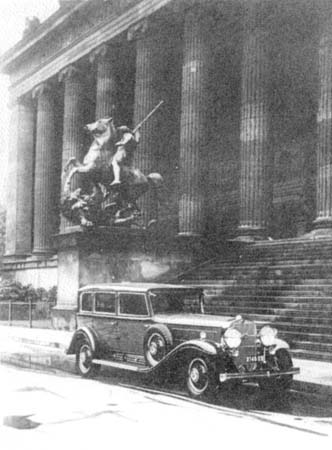
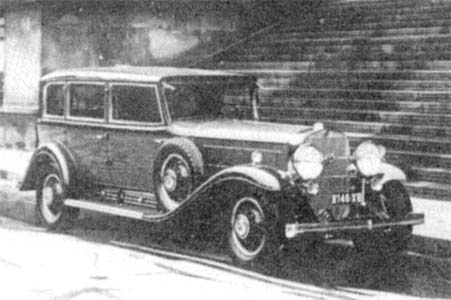
The steps in front of this building - and the French number plate on the car - had me thinking this location was
the cathedral in Cologne; in fact the full background image (above) identifies it as the Altes [old] Museum in Berlin
The museum in the New Millennium, after restoration following WW2
Dresden
(actual venue not known; it looks like an industrial complex)
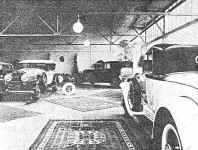
The car in the foreground (Fleetwood style #4376 coupe) was not one of the five tour cars
[more oriental rugs cover the exhibition areas]
Fleetwood style #4260 special phaeton
This photo of style #4175 limousine appears to have been
taken also in Dresden again; similar oriental-style rugs
were spread around also in Nuremberg a few days later
In the same showroom (?); the oval license tag on the phaeton you can see
in the background confirms the cars wore German tags in Germany
Nuremberg
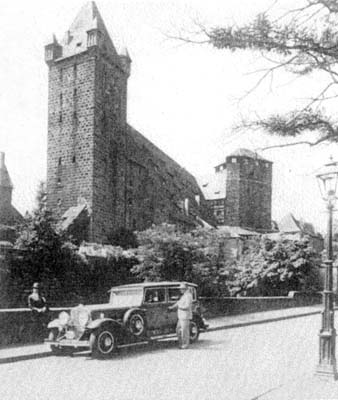
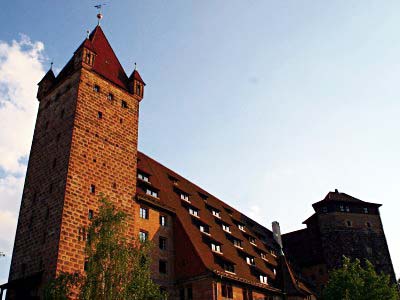
Luginsland tower dominates the Madame X style #4175 limousine;
[center (color) photo shows the historic building today - 2013]
Munich
Siegestor, the Gate of Victory
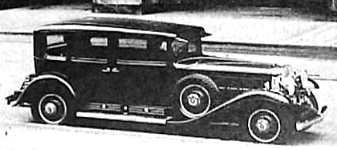
The fine detective work was done by my good South-African buddy, Don Fraser of Dallas, TX;
I simply sent him the photo as a Facebook attachment on May 5, 2014; Don wrote;
Photo of classical "Triumph" arch ... Google searched same ...
The Wittelsbach fountain
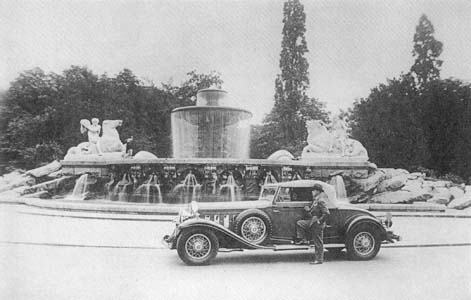
The sporty convertible coupe
Cologne
The Cathedral
The convertible coupe, the town brougham and the special phaeton
Holland
Presumably, the final lap of the German portion of the Tour would have been from Cologne to Essen, then across the border into Holland, en route to Arnhem and Utrecht. There was indeed a reported overnight stay in Arnhem, where the five V-16s were displayed in the show rooms of the local distributor. Mr. K. Landeweer, enterprising distributor for Cadillac and LaSalle cars at General Motors Continental, met the V-16s at the border between Germany and Holland; he remained with the cars for the entire duration of the tour in that country. The towns of Amsterdam, The Hague and Rotterdam also were visited. In Utrecht, Mr. Landeweer's HQ, there was a 2-day showing as well as many demonstration rides. Following a press luncheon and demonstration, a well-known automotive authority wrote a highly laudatory article about Cadillac's V-16 models; it was published in Holland's De Auto. I believe this is it:
This article is from the Utrecht daily Limburger Courrier
Thanks to CLC member, Dirk Van Dorst (coordinator of the club's activities in Europe) and to Paul Ayres (club Vice-President for International Affiliates), I was able to get copies of the article, above, and the two clippings below. My knowledge of Dutch is limited so please forgive my not attempting to translate into English, and in full, these two cuttings. If anyone wants to take them on, be my guest. I did attempt to translate the headlines.
The title of the preceding piece is: THE CADILLAC "SIXTEEN-CYLINDER" CARAVAN; it is sub-titled: A tour along Holland’s highways and was published in the Limburger Courrier (a provincial newspaper from the southern part of Holland) on August 4, 1930 by K. Weyerhorst. The opening line reads: We have received this from Utrecht. the next line begins: It is a sensational feeling to ride in a sixteen-cylinder car for the first time. The Caravan is mentioned only in passing. The onus of the piece centers on past and present Cadillac automobile production with references to V-16 performance and styling
This cutting is from News of the Day, a daily paper published in Batavia, Dutch East Indies
This excerpt is dated July 29, 1930; my own translation reads: The international Cadillac Caravan comprising five deluxe models in the new V-16 Cadillac range were shipped on 12 June aboard the SS Deutschland [in fact the carrier was the S/S United States] with the objective of doing a tour of Europe this summer. The Caravan will visit eight [actually 9] countries; it left Copenhagen on 24 June, to end the trip in Madrid on September 8 [actually it ended in Paris, on September 9]. In the intervening period the following towns will be visited [the actual itinerary and the dates of the visits are not clearly defined; they include Stockholm (Sweden), Berlin, Dresden, Nuremberg, Munich, Stuttgart, Frankfurt, Wiesbaden and Cologne (Germany), Utrecht, Amsterdam, Rotterdam and The Hague (Holland), Antwerp and Brussels (Belgium), Paris (France), Basel, Zürich, Berne and Geneva (Switzerland), Aix-les-Bains, Nice, Toulouse and Biarritz (France) and San Sebastian (Spain).
This clipping is from the West Indian De Indische Courant
The foregoping clipping is from Soerabia in the Dutch East Indies) is dated November 10, 1930; my own translation reads: “Beau Geste” - The Cadillac V-16 Caravan that recently made a trip through Europe, visited the picturesque small town of Cadillac in the South of France, where a wreath was laid on the War Memorial in honor of Antoine de la Mothe Cadillac, founder of Detroit, Michigan.
Despite the requests for information made on my behalf by Dirk Van Dorst (coordinator of the Cadillac and LaSalle Club's activities in Europe) to many known Dutch historians and collectors, including Frans Frijaldenhoven and Koen Ongkioehong (with whom I too have had "Cadillac" contacts in the past), nothing new on the subject has come to light.
Three photos also were published in General Motors Continental during the time the cars spent in Holland; the copies in my possession were scanned from those magazines and many fall short of what one would be needed in the Cadillac Database; a better copy (below) was provided by Peter Ratcliff of Melbourne, Australia.
Vollendam, in Holland, featuring Fleetwood style 4330-S
[General Motors World, September 1930]
While en route from Arnhem to Utrecht, one group photo was taken at the entrance to Huis Doorn, former home of Germany's late Emperor Wilhelm II (1859 – 1941). He was the last German Emperor (Kaiser) and King of Prussia. He was the eldest grandson of the British Queen Victoria (I didn't know that!) and was related to many monarchs and princes including England's own King George V, founder of the House of Windsor. Kaiser Wilhelm supported Austro-Hungary in the crisis of July 1914 that led to the First World War. An ineffective war leader, however, he lost the support of the army, abdicated in November 1918, and fled to exile in the Netherlands where he bought Doorn Castle in 1919 after the debacle of World War I. He lived at the Castle until his death in 1941. At present (2014) that residence is still a museum and mainly about Wilhelm II. Huis Doorn has become a place of pilgrimage for German monarchists; a small but enthusiastic group of them gather there every year on the anniversary of his death to pay their homage to the last German Emperor.
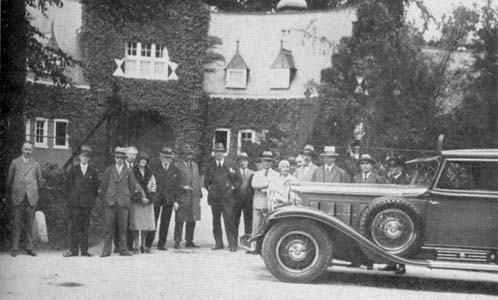
Huis Doorn, Holland, featuring Fleetwood style 4175
[General Motors World, September 1930 - scanned by Peter Ratcliff, Australia]
One report published by General Motors - Continental in Holland identified the correct location of the photo below. I first believed it had been taken somewhere in France, between the Swiss and Spanish borders; in reality it was snapped near Doorn, where the caravan had stopped at the gates to Huis Doorn (above).
Doorn, in Holland
From L to R: Fleetwood styles 4330-S, 4260, 4175, 4264-B and 4335
[General Motors World, September 1930 - scanned by Peter Ratcliff, Australia]
Huis Doorn, former residence of Germany's Kaiser Wilhelm II
Belgium
Following a successful tour of the larger cities and towns of Holland, the Sixteens made their way to Antwerp in Belgium, on July 24. In a progress report published by General Motors Continental around the end of July 1930, we learn that the Caravan had by then completed its tour of Germany, Holland and Belgium. There had been cabled reports (to GM headquarters in Detroit?) reporting similar successes encountered in these three countries as had been witnessed in Scandinavia.
Unfortunately, the archives of GM's facility in Antwerp, Belgium were destroyed (during the war or in a general clean-up after the war?). I put feelers out to friends in that country and others familiar with the V-16 European Tour. So far, there have been few positive responses. Shame!
France
(first lap)From Belgium to France, then Switzerland
However strange it might appear, there are very few reports on the progress of the V-6 European tour in France; photos too are few and far between. What we do know is that the Caravan crossed the border into France, coming from Belgium in the 1st or 2nd week in August.
Note that most businesses in France close down during the (hot) month of August. That's when an estimated 80% of the otherwise active French population ceases all forms of work and heads for the country's major "recreational areas", being on the coasts of the Mediterranean sea, the Atlantic ocean, the English Channel (known in France as La Manche) and the French Alps. This could explain France's apparent "silence" regarding the V-16 European tour, even if such essential annual vacation time was taken at one's own expense. It was only in 1936 and thereafter that French workers began to enjoy paid leave.
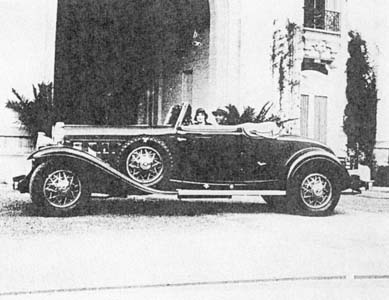
Posing in front of the Hotel Hermitage in Vittel, a spa resort in eastern-central France
The former Hotel Hermitage, in front of which the V-16 convertible coupe
was photographed in 1930 (above pics) is now the Hotel Continental
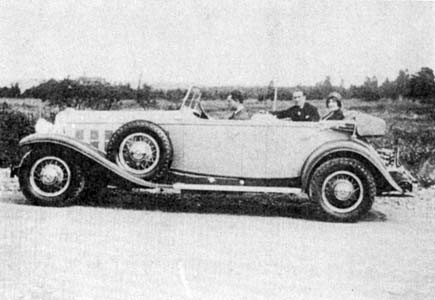
Driving to the Vittel golf course in style, aboard the "Style" #4260 special phaeton
In order to reach Vittel, a thermal spa town in eastern France, and from there the Border town of Basel, in Switzerland, my best guess for this part of the itinerary would be south-east from one of the Channel resort towns to Béthune, then Arras, St. Quentin, Laon, Reims (Champagne country), Bar-le-Duc, Toul, Vittel, Epinal and Belfort or Mulhouse.
Switzerland
Strange as it may seem, I have found no photographic record of the five V-16's having crossed into Switzerland (most certainly coming from France) and having driven through some of the most scenic countryside in this part of the world.
I have put feelers out to the Chambers of commerce of the principal cities and towns visited (i.e. Basel, Zürich, Lucerne, Berne - the capital city - Lausanne and Geneva), as well as to the two major automobile clubs that were in operation in that country already the 30s.
France
(second lap)Switzerland to France
To get from Geneva, Switzerland, to the Spanish border at Le Perthus via Aix-les-Bains and Nice (two of the published destinations), my itinerary of choice would have been Geneva, St Julien-en-Genevois (the border crossing from Switzerland into France), Aix-les-Bains, Gap, Sisteron, Nice, Marseilles, Arles, Montpellier, Béziers and Perpignan to Le Perthus. There are again no known photos taken in these towns.
Spain
The most logical itinerary after Le Perthus, in France, would have been Barcelona, Lerida, Saragossa, Madrid, Burgos, Bilbao, to San Sebastian. Although not mentioned as one of the Spanish tour destinations, I am convinced the V-16s visited the capital, Madrid. The cars are known to have been in San Sebastian on August 27 and 28, en route from Spain back to France.
The image below (and the enlargement) is from the book Cadillac Eldorado by James W. Howell and Jeanna Swanson Howell. The text that accompanies the image reads (in part): This picture shows one of several (V16 models) that made an introductory tour through Europe beginning in the summer of 1930. The trip included a visit to the ancestral home of the Cadillac family in France [author's note: there never was such a "Cadillac" family in France]. It seems that the tour visited San Sebastian (on the Spanish border with south-western France) on August 27 and 28, en route back to France.
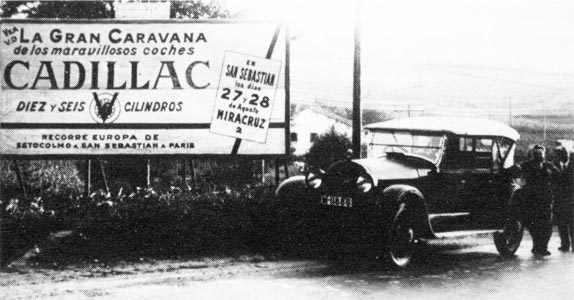
I believe the car in the LH photo is a Cadillac from the early 20s (it is NOT
a V16 model); it appears also to carry license tags from Madrid, in Spain;
the text on the billboard beside the car (see enlargement at right) reads:
See the Grand Caravan
of Marvellous Cadillac Cars
Sixteen Cylinders
_________________________
European Tour From
Stockholm to San Sebastian to Paris
[inset, right]
In San Sebastian
on
27 and 28 August[at]
Miracruz
France
(third and final lap)
Spain back to final destination in France
In the town of San Sebastian, SW France
[ Photo: courtesy Barry Dougherty, via Anders Läck ]
[Lower photo: Google Maps, Internet]
The published reports state that the V-16 Caravan left San Sebastian, in Spain, around August 29. From this time-frame, we may readily establish that the cars were on the road from San Sebastian in Spain, on August 28-29, headed to Toulouse and thence to Cadillac, Bordeaux, La Baule, Angers and Paris.
A photo in one of the published records of the V-16 European Tour shows the five cars parked on the street in front of an establishment that appears to sell light fare, snacks and beer (see photo, above). The location was identified by one researcher as San Sebastian whereas I believed the photo was taken in the small town of Le Perthus, on the French side of the southern border into Spain. We both were wrong. The photo was taken precisely at #42 rue Charles Pucheu, right on the Spain's northern border (at Irùn) and France (at Hendaye/Urrugne).
Once again, some fine detective work was done by my good buddy, Don Fraser; I had sent him the photo as a Facebook attachment on May 5, 2014. He wrote: Juan Casamayor and Brasserie suggest south of France and Basque country ... Did a quick google street view of border towns et voilà ... Oh yeah, a lot of luck too!
Anyway, I found on Google Maps (brilliant web site!) that very place as it looks today; it is almost unchanged. Don says it is still a brasserie and the building on the left was actually built as a bank; it is currently (2014) the Banque Michel Inchauspé at the same location. Hendaye-Urrugne sits on the Bay of Biscay, on the Atlantic side of the Pyrennees. Here is a screen shot as well as the URL for the Hendaye photo:
Left: The dry moat surrounding "Château Cadillac" in the town of the same name
[General Motors World, November 1930]
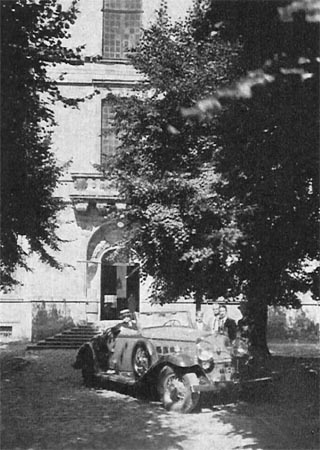
The V-16 convertible coupe
[General Motors World, November 1930 - scanned by Peter Ratcliff, Australia]
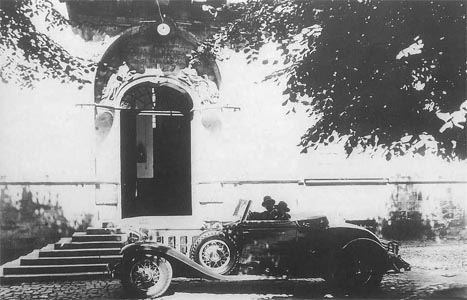
Same car, same location, different angle
[ Photo: courtesy Barry Dougherty, via Anders Läck ]
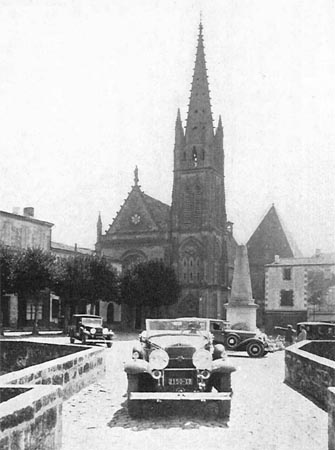
The 4260 phaeton posing before St. John-the-Baptist cathedral in Cadillac; behind it (left)
style #4264B, the Town Brougham; (right) the Madame X style #4175 limousine and (far right) #4330S sedan
[General Motors World, November 1930 - scanned by Peter Ratcliff, Australia]
Toulouse is listed among the 44 towns visited by the Sixteens, but we have no photographic or other record of the V-16 Caravan in that city (where my wee brother, Malcolm, earned his doctorate in veterinary medicine in the the early 70s); I had to find for that town a logical itinerary. It had to be either en route to Spain, coming from Geneva, or coming back into France, from Spain, at Hendaye en route back to Paris. The latter seemed to me to be the more logical choice, although it did mean "looping backwards", east, before then heading north and west to Cadillac and Bordeaux.
I had a job fitting Toulouse into the itinerary in France but have hazarded a guess that the cars went there directly after crossing the border from Spain back into France at Hendaye, en route to Cadillac, Bordeaux, La Baule and Angers.
The market town of Cadillac was next on the list although it bears no relation - other than by its name - to the founder of the city of Detroit. The self-styled "Sieur" (sire) Antoine de la Mothe-Cadillac was just a local Gascon adventurer, a commoner; he was born Antoine Laumet. He set sail for the New World in 1683 and founded in 1701 a trading post he named Les Etroits (the Narrows) that would become the future City of Detroit. Laumet added "Cadillac" to his name simply because it had a nice, military "ring" to it, compared to his real monicker. For the history buffs among you, I recommend you check out the real facts in these pages.
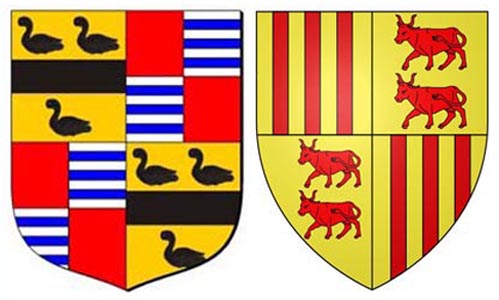
Left: Cadillac crest devised by Antoine Laumet while in New France
Center: Crest of the town of Cadillac in France
Far right:
The stop at Cadillac was motivated by the erroneous belief that Detroit's founder was somehow related to the ancient Dukes of Epernon and their Château-Cadillac. In the General Motors World issue for November 1930, the copywriter states: No tour of France by the latest Cadillac models would have been complete without a visit to the town named for the founder of Detroit [my emphasis]. In fact, the town was named by England's Edward I who built a fort there in the 13th century (1280) to defend Bordeaux from the French; the ramparts themselves were not completed until 1315.
In Bordeaux, below, about 100 miles north of Cadillac, there was another photo shoot.
[Photo: Google Maps, Internet]
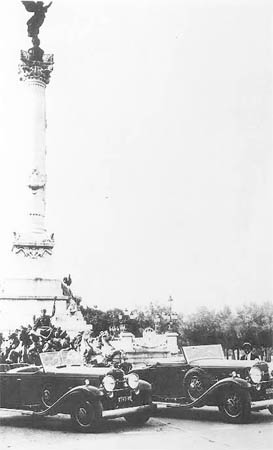
Initially, I thought the above photo (left) and the enlargement (top) was taken in Paris; but thanks to Bruno Amiot of Angers, France, I know now that it was taken
in Bordeaux, in front of the Girondins monument (a tall column and fountain that stands on Quinconces Square - color photo); an optical illusion caused by the
camera lens and the angle at which the photo was taken, makes the #4260 phaeton in the foreground look smaller than the #4235 convertible coupe behind it
[ Photo: courtesy Barry Dougherty, via Anders Läck ]
From Bordeaux, the cars then continued north to La Baule, a seaside town and spa that boasts the longest beach in France [BTW, it may not interest you to know that on a warm summer's evening, in August 1938, my parents conceived me on a sandy beach near Préfailles, which is actually about 35 miles south of La Baule ... and Préfailles is not surpringly where I would like my ashes to be spread on a sandy beach on an ebbing tide!]
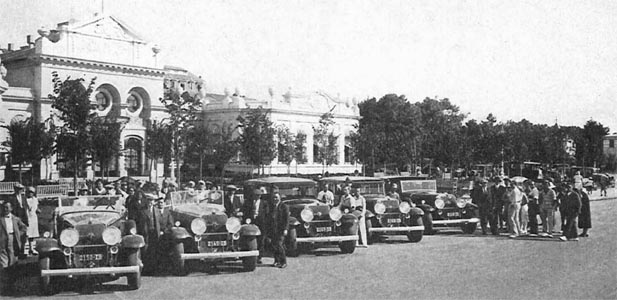
This photo from General Motors World magazine for November 1930 shows the five Sixteens lined up in front of the casino
[General Motors World, November 1930 - scanned by Peter Ratcliff, Australia]

Another view of the same line-up, courtesy
[ Photo: courtesy Barry Dougherty, via Anders Läck ]
The next stop after La Baule we know for sure was Angers, 185 miles east of Paris. The cars were in that town on September 6-7; that means they spent 8-9 days in SW France. By then the V-16 caravan had been in Europe already for some three months and probably was ready to head "home".
In August 2005 I had a contact with Bruno Amiot, a researcher from Angers' town council; he recalled that the caravan had stopped there in September 1930, as evidenced by two cuttings he kindly sent me from the local newspaper, Le Petit Courrier. He included two period photos (one is shown below). The press cuttings show that the cars had come from La Baule, where they probably spent a couple of days on September 6-7, and would be on display in Angers on September 8-9. An advertisement in the local press mentions that from 4 p.m. on September 8 until noon on September 9 the "Sixteens" would be on display at the local GM/Cadillac dealer, Laudreau & Co., at the Central Garage.
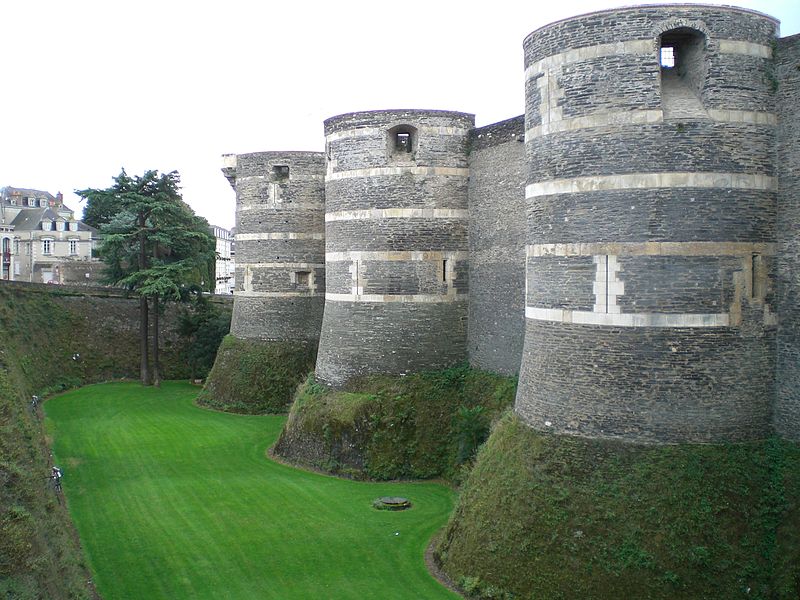
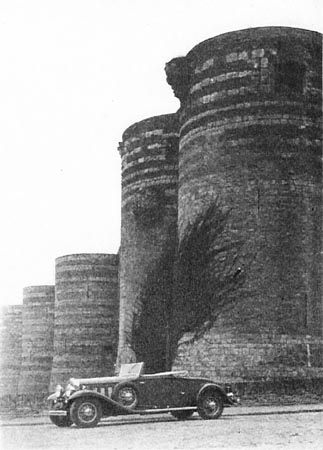
Originally, this castle was built as a fortress in Roman times. The huge castle was built starting in 1234
before King Louis IX turned 21; he was known as Saint-Louis; in 1246, he gave the castle to his brother, Charles
[General Motors World, November 1930 - scanned by Peter Ratcliff, Australia]
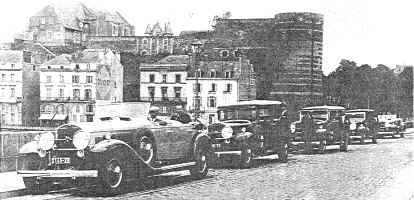
The order appears to be the same as in San Sebastian: leading the group of five
is style #4260, followed by styles #4330-S, #4175, #4264-B and #4235
[General Motors World, November 1930]
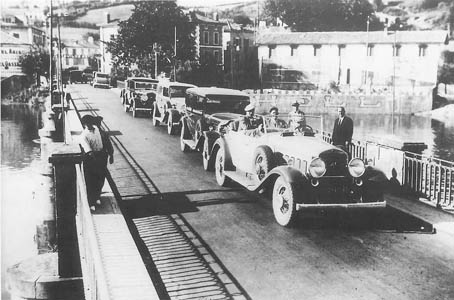
This photo (including the cropped and enlarged copy) was acquired in 2014 by Anders Läck, my Swedish friend
and Euro-Tour researcher par exellence; all five cars are shown, but the convertible coupe is hidden behind the Town Brougham
[ Photo: courtesy Barry Dougherty, via Anders Läck ]
Thank you Bruno Amiot, a local Angers resident, who provided also an old photo of the same bridge taken early last century; he added: this view of Angers is taken from the Basse-Chaîne stone bridge: in the background you can see the beautiful homes on Quai Ligny (now destroyed) that stood below the castle; on the bridge paving you can see the old tramway rails
Cuttings from Angers' daily Le Petit Courrier
[ September 7, 1930 ]
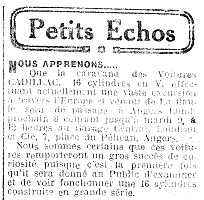
The text on the LH ad reads: We have learned that the caravan of sixteen-cylinder Cadillac cars currently on a grand tour of Europe will stop in Angers, coming from La Baule, on Monday, September 8, staying until Tuesday 9 at noon, in the Central Garage, Laudrau & Co., 7 Place du Pelican in Angers. We are convinced these cars will enjoy a great success among the curious public who for the first time will be able to inspect and to see in operation a mass-produced (?) sixteen-cylinder motor car.I tend to think that no "Tour" of Europe, and especially of France, would have been complete without a leisurely drive through the Loire valley as well as a visit to the Eiffel Tower in Paris. I wonder if the five Sixteens glided through France's immensely popular "Château" region, in the Loire valley, before reaching Paris (I have seen only one report - from a Dutch press cutting, above) where the caravan is mentioned as having visited the "City of Lights".
Strange as it may seem there are no known photos available for the final visit to Paris. Reports further indicate that all the cars remained in the French capital until buyers were found.
Information Wanted
What we are missing now are the actual towns and specific locations where the cars shown below were photographed.
Somewhere in France (?); note the French flags in the background, behind the convertible coupe and the sedan at the right
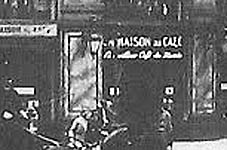
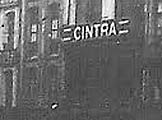
French advertising signs in the enlargements, above (e.g. "Maison du Café", "Cintra", "Roneo"), suggests a location
somewhere in France (Paris perhaps?) or Belgium (Wallonia), or even French-speaking Switzerland
Unknown location; language of sign (Internationale Auto) could be in French, German, Dutch or Flemish;
in these conditions, it will be difficult to decided on the country and location where the photo was taken
Missing also are photos and press accounts from a number of the countries through which passed the caravan and (apparently) did NOT get much press coverage ... or photos and comments were suppressed. Indeed, I fear that when Mr. Sloan got from Mr. Osterman so many negative comments about the cars and the general situation that obtained during the tour in Sweden, that he may have decided to curtail the program and keep published comments to a minimum owing to the bad press he had got via the the GM Export office in Paris! It seems odd, for example that countries like Belgium and especially Switzerland got NO coverage in General Motors World or General Motors Continental. Mysterious also is that fact that there appears to be NO photos or press releases from Paris' General Motors (France).
In order to complete the story of the 1930 Cadillac V-16 European Tour, we are looking for any articles or photos relating to the "European Tour" of these five magnificent Cadillac cars that may have been published at the time, in any of the countries that we know to have been included in the tour itinerary. At this writing, Sweden has been the most prolific in supplying the kind of information we need. France comes second, but with only two small cuttings from a single regional newspaper and a very few photos. In Holland and the Dutch East Indies, three press cuttings were found, thanks to research carried out by Dirk Van Dorst.
Of course we need also good digital scans of any issues from 1930-1932 of General Motors World as well as General Motors Continental that might include articles, photos, snippets relating to the Tour. Surely there are more out there ...
I would like to find also issue #92 of France's Auto-Carrosserie (or a good digital scan thereof). I believe that issue was published circa 1930-31. It may contain information regarding the Town Brougham (#4264B) that was possibly acquired and modified by the Dutch coach-builder, Bronkhorst.
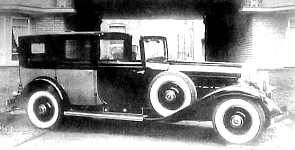
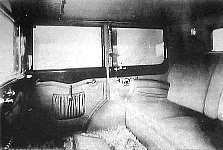
This is believed to be the tour car after possiblz undergoing some modifications by Bronkhorst of the Netherlands
[ these poor Photos are from France's Auto-Carrosserie No. 92, circa 1930-31 ]
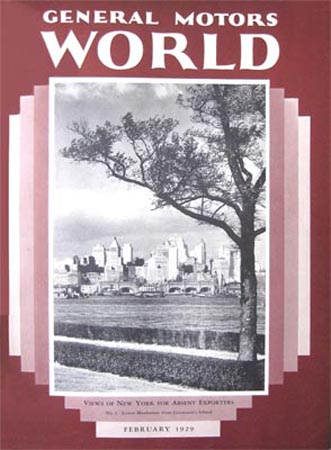
Does anyone have issues of this corporate magazine for 1930-31-32?
These issues are dated February, 1929 and June 1930; we have access
also to the issues for August, September and November, 1930; we are looking
specifically for other issues that include European Tour facts or photos
What became of the five Tour Cars?
We know that one of the tour cars (Fleetwood's special phaeton style #4260) remained in the French capital after the promotional tour. It was acquired by French master-coachbuilder, Jacques Saoutchik who removed the body and replaced it with a special, sliding-roof sedan (photo below). By the way, that original Fleetwood special phaeton body was subsequently re-mounted on V-16 chassis #701554. It resides again in the USA where it still survives.
It is believed that Fleetwood style #4260 (body #2) was built originally on chassis #700004; it was the third V-16 to come off the line and the second such Fleetwood body style. It was put later on VIN #701554 and was sent on the European Tour with its four sister cars. The factory build sheet lists it (erroneously) as an "all-weather phaeton" whereas it is definitely Fleetwood's dual windshield "special phaeton". As I have mentioned above, the #4260 special phaeton remained in France; the body was removed and the chassis got custom coachwork by Jacques Saoutchik. The original special phaeton body was ultimately recovered (where? when? by whom?) and put on another V-16 chassis [VIN 700979?]. I saw that car at a Barrett-Jackson auction in January, 1998. It was gray-mauve with matching leather trim and trunk. Later still, the Saoutchik body was removed and the special phaeton body (the original body for that chassis) was re-mounted in its place. This is now CLC Senior car #141 and was owned in 2002 by Steven Nanini of Tucson, AZ. It was completely restored there, to the highest standards, by respected restorer Fran Roxas of Alsip, Illinois for Fred Weber of St. Louis, MS.
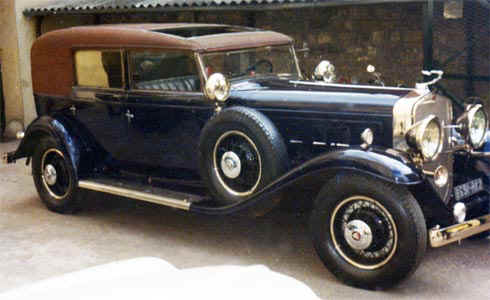
"Before" (left) and "After" (right) photos of Jacques Saoutchik's
sliding-roof sedan conversion of Fleetwood style #4260 special phaeton;
this car is believed to be currently (2013) in Finland
Two of the five cars went to Switzerland. They were acquired by a pair of wealthy Swiss businessmen. The Fleetwood style #4235 went to a new owner in Basel, while the demonstrator-car (Fleetwood style #4330S) found a new home in Geneva. according to the report in General Motors World for November 1930, that car was acquired by a gentleman who had made his fortune in America and who had returned to Switzerland after retiring from business. Where is it today?
These two are NOT the actual tour cars
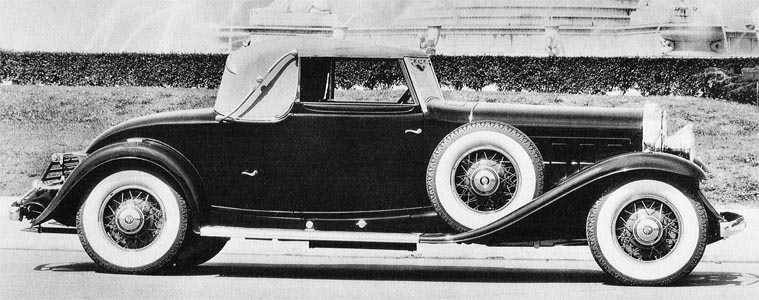
Left: Style #4235 went to Basel
Right: Style #4330S went to Geneva
One of the last published reports about the European Tour cars [November, 1030] said that the other three models had been retained in Paris for demonstration purposes during the Automobile Salon held in the City of Lights every year in October. That is a highly plausible.
In this regard, in the spring of 2014 I found in La Cad (the club magazine of the Australian CLC), on p.7 of the issue dated Winter 2013, an old photo of the #4175 Madame X limousine (style #4175) that carried the French license tag #2148XB during most of the tour. Although the number plate is quite fuzzy in the two images below, it certainly seems to be that registration number. The caption to the photo reads: From a 1931 copy of General Motors World [what month?] comes this photo of a V-16 Cadillac being loaded onto a ship at Morocco, the car is LHD and appears to be a slant-windshield style. I am keen to get a copy of that issue of GM world to see if the original photo shown there is of a higher resolution than these two. I would also like to know what became of that car! Could it have been acquired by HM King Mohamed V, who reigned over of Morocco from 1927 to 1961? We know his eldest son, HM King Hassan II, was a keen car collector. Anyone seen his collection?
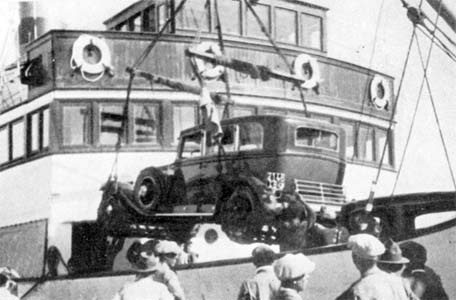
(Left) This photo and the enlargement (right) are from a 1931 issue of General Motors World - scanned by Peter Ratcliff, Australia]
There is a remote possibility that the last car in the group (Fleetwood style #4264B town brougham) found its way back to Holland, where it had been on display from circa July 24 to 29, before proceeding to Antwerp, in Belgium. I have a poor photo of a car very similar to it, with a modified town car body by Bronkhorst of Holland; that car features quarter windows and a body extended a few inches to accommodate twin, forward-facing, full width auxiliary seats. It is a shame that such a grand "classic" should have apparently disappeared; it may well be that it was seized by the Nazis, as a "spoil of war" during their occupation of Holland. If that were the case, it is doubtful it would have survived the massive allied bombings of major German cities during WW2.
Again, this may not be THE actual tour car
(it's a factory publicity shot)
Above: the tour car, Town Brougham, style #4264B
This is the interior of a "rebuilt" Fleetwood style #4264B town brougham;
you can tell from the photo below (left) that the body has been
stretched a few inches and that quarter windows have been added
This photo does NOT relate to the European Tour "Sixteens" but shows the first
dozen (?) "Sixteens" delivered by GM to .......................... ???
Tour Car Trivia
Trivia 1: It is worth noting that England's Motor Sport for November, 1962, recalled (p.894) that "several" V-16s were seen in Cologne in 1930. The writer did not question why the cars had not come to Britain that summer. It seems strange, in my opinion, that England was not on the initial itinerary. But perhaps a visit to that country was not considered essential at the time, considering that the company was planning to show a couple of Sixteens at the Olympia show in London that coming Fall (October, 1930).
Trivia 2: Interestingly, in all the photos I have seen that were taken during the tour (some of them are shown above), you can see that none of these cars seems to have a Goddess hood ornament or any of optional sidemount covers. In addition all but one of them have regular, black-wall tires. The convertible coupe has the optional, chrome-plated hood louvers, as does also the special phaeton with secondary windshield.
faceTrivia 3: A reported seventy orders for V-16 models were taken during the European tour. This number corresponds to the recorded export sales of the V-16. Of these, fourteen units went to Antwerp, in Belgium, twelve to Madrid, in Spain, eleven to Berlin, in Germany (of which one style 4325C town car landaulet, licensed #1A75825), seven to Mexico City, in Mexico (were the orders taken in Europe???), six to Paris, in France (of which at least one style 4130 and one 4330 - possibly the tour car - or 4375 with French tourist registration No. 2017XB), five to Stockholm, in Sweden, four to Copenhagen, in Denmark, only two to London, in England [possibly because the caravan did not stop there, two to Buenos Aires, in Argentina (engine #701530 was one of these; it is currently in Spain, mounted in a custom-bodied V-16 racer), two to Havana, in Cuba (one was a style 4391 Town Car Brougham, the other may have been a style 4175 Imperial), one to Bombay, in India (a style 4260 sport phaeton with RHD, for the Maharajah of Tikari), one to Manila, in the Philippines, one to Honolulu, in Hawaii (Hawaii did not become a State of the Union until 21st August 1959, one to Moscow, in the former USSR and one to Port Elisabeth, in South Africa (a RHD style 4380 all-weather phaeton). One additional unit (Fleetwood style #4291) went to the Royal Thai household in Bangkok, Thailand. This unit appears to have been a domestic purchase that was subsequently exported and, therefore, is not included in the official export total.
Finally, a call (in French) to French readers of the Cadillac Database as well as to Parisians who know the confines of their city:
Appel aux amateurs français :
Allons, les chercheurs parisiens, quelqu'un doit bien se souvenir avoir vu passer dans Paris, en été 1930
(du moins en photos), un cortège de CINQ magnifiques Cadillac V-16) ! On sait que l'une d'elles
fut acquise - après le pèriple d'environ 3 mois à travers l'Europe - par le carrossier bien connu, Jacques Saoutchik.Après maints périples celle-là est retournée aux Etats-Unis à la fin des années '80
Par ailleurs...
Qui connaìt cet endroit? On dirait Paris, mais je me trompe peut-être


Return to The (New)
Cadillac Database© Index Page
or go back to the V-16 index page
© 1996, Yann
Saunders and the Cadillac-LaSalle Club, Inc.